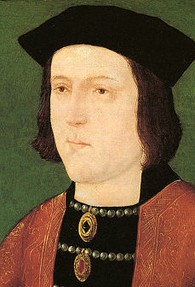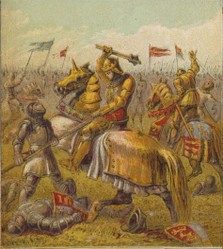On April 9, 1483, Edward IV died. It was relatively sudden, although he did have the time to change the Protector for his son, Prince Edward. However, he could never control the events that happened after his death, and it arguably led to the end of the Plantagenet dynasty just over two years later. His death would lead to the mystery that still haunts historians today: the disappearance of the Princes in the Tower.

The Death of Edward IV: Leading to the End of the Plantagenet Line
Edward IV died on April 9, 1483. It would lead to a change to the line of succession and the end of his family line.
How Did Edward IV Die?
Was it natural causes or did someone poison him?
 While the exact cause of death is not known, there are a number of highly suspected reasons. Pneumonia is the most widely accepted cause of death of Edward IV, and it definitely makes sense. He fell ill around Easter of 1483 and lasted long enough to make a few changes to his will. However, he was mostly bed-ridden by the time he was making these changes, and it was clear that there was nothing anybody could do to help him.
While the exact cause of death is not known, there are a number of highly suspected reasons. Pneumonia is the most widely accepted cause of death of Edward IV, and it definitely makes sense. He fell ill around Easter of 1483 and lasted long enough to make a few changes to his will. However, he was mostly bed-ridden by the time he was making these changes, and it was clear that there was nothing anybody could do to help him.
Typhoid is another cause that is widely accepted for many of the same reasons as pneumonia. Both of these illnesses were also extremely common during this time, and there was little medical knowledge to help those suffering from either of them.
Some historians believe that he died due to his poor and unhealthy lifestyle. As he aged, his health started to fail. He struggled to move around as much, and became inactive. However, his appetite didn’t leave him, and he continued to eat as he used to. This could have led to other ailments, which took his life in the end.
A final theory is that he was poisoned. There were certainly enough people around who would have wanted the throne. However, there were two princes that would need to be removed first, and England loved Edward IV. He had proved to be a good king to his people, and tried to limit the number of wars after he gained his crown. He even worked with France, giving up some land, instead of continuing The Hundred Year’s War.
Natural causes have been accepted as the cause of death, and it means he is one of the only men in his family to have died from natural causes. His grandfather was executed and his father killed in battle. Two brothers were also killed in battle, with another being executed under Edward’s own orders. His sons are another story. There is the possibility that they died from natural causes, but there is also the chance that they were murdered to place Richard III or Henry Tudor on the throne. There is no proof since their bodies have never been found.
Placing Richard III as Protector
Naming Richard III as Edward V's protector may have been the worst thing Edward IV could have done.
 In hindsight, one of the worst things that Edward did was make his younger brother the Protector of the young King Edward V. Richard used the power for his own gain, making the marriage between Edward IV and Elizabeth Woodville invalid, so all children from that marriage were illegitimate. It meant that Edward V could no long be king, and Richard III was the next in line. Whether there were grounds for this or whether Richard was coerced by others remains unclear. There is the possibility that Edward married someone before Elizabeth in secret, which would have invalidated their marriage.
In hindsight, one of the worst things that Edward did was make his younger brother the Protector of the young King Edward V. Richard used the power for his own gain, making the marriage between Edward IV and Elizabeth Woodville invalid, so all children from that marriage were illegitimate. It meant that Edward V could no long be king, and Richard III was the next in line. Whether there were grounds for this or whether Richard was coerced by others remains unclear. There is the possibility that Edward married someone before Elizabeth in secret, which would have invalidated their marriage.
Read More About the Princes in the Tower on Wizzley
However, it was a big mistake to mess with the line of succession. Arguably, the only reason Richard was able to gain the trust and love of the people is because of his wife Anne Neville. She helped him gain the love of the north, while Richard had the love from those in the south. If it wasn’t for that, they could have turned on him the minute the two boys in the Tower went missing.
The End of the Plantagenet Line
The Plantagenet line came to an end after Henry Tudor defeated Richard III at the Battle of Bosworth.
The Plantagenet dynasty died out just over two years after Edward IV’s death. This was likely due to Richard III’s decisions. Had Edward V been allowed to rule, Elizabeth Woodville would never have conspired with Margaret Beaufort to place Henry Tudor on the throne. The Battle of Bosworth would never have happened, and Edward V may have grown up to have a family of his own; continuing the family name.
 |
| The Plantagenets Only $14.08 |
Instead, Richard removed the heir and tried to place his own line on the throne. Unfortunately for him, his own son died (strangely enough on April 9 1484!) and there were no Plantagenet heirs.
Technically, Edward IV’s line was able to continue but under a different name: the Tudor name. Henry Tudor sailed from France and defeated Richard III at the Battle of Bosworth. He then married Elizabeth of York, the eldest daughter of Edward IV, after invalidating the act against the legitimacy of her birth. The Tudor line lasted until 1603 and then changed to the Stuart dynasty. However, it has always been linked to Edward IV (and still is today) through Elizabeth of York.
The Burial of Edward IV
Who is buried with Edward IV?
 Edward was buried at Windsor Castle. He was later joined by his wife, Elizabeth Woodville. In 1789, the vault was accidentally opened, and it led to the finding of two bodies. These bodies were assumed to be two of their children who had died before them: George and Mary, who had died at the ages of two and 14 respectively. No examination work was carried out.
Edward was buried at Windsor Castle. He was later joined by his wife, Elizabeth Woodville. In 1789, the vault was accidentally opened, and it led to the finding of two bodies. These bodies were assumed to be two of their children who had died before them: George and Mary, who had died at the ages of two and 14 respectively. No examination work was carried out.
However, during the restoration work between 1810 and 1813, two more lead coffins were found. These were both labelled George and Mary Plantagenet. It became clear that the initial two bodies were never the two others assumed. The two lead coffins were moved to be with their parents, but the other bodies were never removed to be identified. There is the possibility that these two coffins actually belong to the Princes in the Tower, but without DNA work and further examination nobody will ever know.
Edward IV’s death on April 9, 1483 drastically changed the course of the future. His 12-year-old son would never get the coronation planned, and the Plantagenet line would come to an end over the next two years.
You might also like
An Overview of the Wars of the Roses Part TwoThe Medieval struggle for the English crown continues. The House of York and ...
Dick Whittington and His CatDick Whittington and His Cat is a less-known fairy tale about a poor boy who ...




 Alternate History: What If Mary I Had a Child?on 01/26/2015
Alternate History: What If Mary I Had a Child?on 01/26/2015
 Francis II of France Dies: Mary, Queen of Scots Returns Homeon 12/05/2014
Francis II of France Dies: Mary, Queen of Scots Returns Homeon 12/05/2014
 Does Writedge Pay? Payment Proofon 12/03/2014
Does Writedge Pay? Payment Proofon 12/03/2014
 Alternate History: What If Lady Jane Grey Was Not Deposed?on 11/11/2014
Alternate History: What If Lady Jane Grey Was Not Deposed?on 11/11/2014



Comments